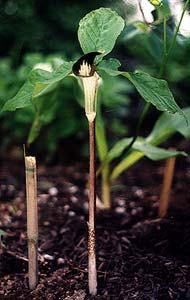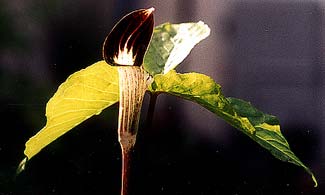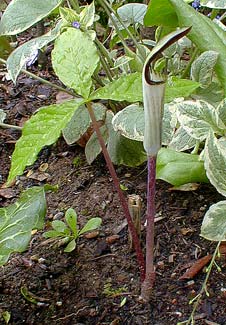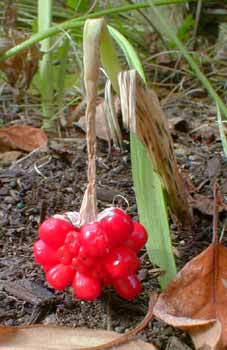 American Jack-in-the-Pulpit
American Jack-in-the-Pulpit
"Jack-in-the-pulpit
Preaches to-day
Under the green trees
Just over the way."
-Clara Smith
before 1920
before 1920
Arisaema triphyllum, or Jack-in-the-Pulpit, is also known as Indian Turnip, Indian Almond, Pepper Turnip, Marsh Pepper, Bog Onion, Priest's Pentle, Wood Pulpit, Little Pulpit, Cuckoo Flower, Starchwort, Memory Root, Devil's Ear, Dragonroot, Brown Dragon, & even occasionally, half in jest, Jill-in-the-Pulpit, when a flower is recognized as the female.
Though small & humble & fond of dark corners of a woodland garden, this is one of the most charming plants in the whole world. The umbrella of three leaves, somewhat like trilliums, can grow two feet tall or taller, though one foot is more likely. Most of our several specimens remain only a foot tall or smaller, but in 2003, one was unexpectedly large, & portraits of it are on the A. triphyllum page of the Pulpit Gallery; possibly that one got so big because it was a female flower, but it didn't produce berries if so.
Either underneath or in front of each triple-leaf umbrella stands a short upright Jack-in-the-Pulpit. The first two flower portraits on this page were taken in May (2002), & the third is from April (2003) when the triple-leaves are not yet full sized. The "pulpit" is the spathe, which is green & white. frequently streaked with purple. That fellow "Jack" is the spadix inside the pulpit, covered with miniscule male or female flowers. If it per chance does pollinate, then late in the summer the spathe falls away, revealing shiny vermillion berries, which wildlife regard as tasty.
 A. triphyllum is famed for the sex-change performance of the flowers. The flower is male or female, but this can change from year to year. It takes more than one to ever have the berries, & it may take several since the male flowers are produced more easily than the female.
A. triphyllum is famed for the sex-change performance of the flowers. The flower is male or female, but this can change from year to year. It takes more than one to ever have the berries, & it may take several since the male flowers are produced more easily than the female.As a generality, younger plants, or plants that were stressed in previous years, produce only male flowers. Older plants (& they can live for twenty or a hundred years), if they have been doing quite well & have stored up lots of energy in the root, produce female flowers, using the stored energy to bring the berries to ripeness.
For the first few years of flowering there may never be berries, but eventually the fruits will become quite reliable.
 The fourth photo from October (2004) was the first of our many American jack-in-the-pulpits to produce a cob of seeds. It stood straight & tall for several weeks, then after it had been ripe for some while, the stem softened & the seeds fell over. When they fall on the ground, ants or beetles are expected to separate individual fruits from the cluster to cart them away, clean the pulp from them, then leave the seed somewhere to take root.
The fourth photo from October (2004) was the first of our many American jack-in-the-pulpits to produce a cob of seeds. It stood straight & tall for several weeks, then after it had been ripe for some while, the stem softened & the seeds fell over. When they fall on the ground, ants or beetles are expected to separate individual fruits from the cluster to cart them away, clean the pulp from them, then leave the seed somewhere to take root.When sewn in situ, it is best done as as soon as the seeds ripen, or about mid-autumn. It is often recommended to wear gloves while cleaning off the pulp because it can be blistery due to high levels of calcium oxylate. But I didn't bother with gloves, & did not find the pulp even slightly caustic to the touch. I quickly washed my hands before I accidentally touched my eyes or nose, though.
I cleaned the mushy overripe pulp off the seeds & let them dry for a single day before I planted them shallowly in compost-enriched soil at the dripline of a Dawn Viburnum, where they may or may not develop over time. They will start to bloom after three years.
For more certain luck with seeds they should be started in coldframes or greenhouse, & transferred to permanent locations in the garden when they are a two years old, during autumn dormancy. Seeds don't like to be stored; the percentage of germination drops dramatically if dry storage is attempted, although they may tolerate brief dry storage.
I don't find it easy to sex the flowers but a good eye might find it easy indeed. The males are on average smaller, but for sure will have a small opening at the base of the spathe permitting the pollinator to escape after travelling through the spathe getting pollen all over itself. The bottom of the female spathe has no exit, trapping the pollinator & forcing it to wander about inside the spathe pollinating all the flowers on the jack.
 The berries are not regarded as edible for humans, even though the majority of Jack-in-the-Pulpit's toxicity is in the stems & root rather than in the fruit. Many toxic plants want their seeds dispersed by animals, therefore the fruit is safely eaten & the seeds expelled unharmed by digestion, & I suspect A. triphyllum properly processed would be safe; but my suspicion is not strong enough that I'd ever risk chowing down on the fruit!
The berries are not regarded as edible for humans, even though the majority of Jack-in-the-Pulpit's toxicity is in the stems & root rather than in the fruit. Many toxic plants want their seeds dispersed by animals, therefore the fruit is safely eaten & the seeds expelled unharmed by digestion, & I suspect A. triphyllum properly processed would be safe; but my suspicion is not strong enough that I'd ever risk chowing down on the fruit!Yet the bitter, toxic root definitely can be rendered edible & is a traditional wild-gathered aboriginal food. One recommendation is that the root be fully dried for from three to six months before it is safely to be cooked & eaten.
This native perennial, so common in the Appalachian Mountains, has a broad range, being found from high in Canada all the way down to Florida, & in temperate regions of the midwest, with many variant forms, a few subspecies, & regionally unique populations.
They grow in woodlands, especially in very soggy areas, but can also take hold in dry forest litter. It is rare to see more than a very few in a given spot. They are quite adaptable & may be found rooting themselves in uncomposted leaf rubble or any moist medium, just so long as they have acidity & shade, & good drainage so that they are not too wet when dormant.
Aboriginal America knew it to have medicinal value, using jack-in-the-pulpit for soar throats, expectorant, & diaphoretic. Research into potential medicinal value of chemical constituents of arisaema have been conducted mainly on Asian species & are not identical species to species. Although the American species is rarely used, some of the studies done in China may apply to the American jack-in-the-pulpit, such as the anti-convulsive activity of Arisaema japonica tested in 1966 by Yao Xue Xue Bao et al.
It is sufficiently dangerous to ingest raw without medical supervision that it is not recommendable. The chances of actually dying from ingesting jack-in-the-pulpit's root or a corm might be slight, but the burning sensation in the mouth would be enough to convince the seeker-after-magic-cures that gobbling down such a remedy may well have unhappy consequences.
Arisaema triphyllum ssp pusillum
Swamp Pulpit